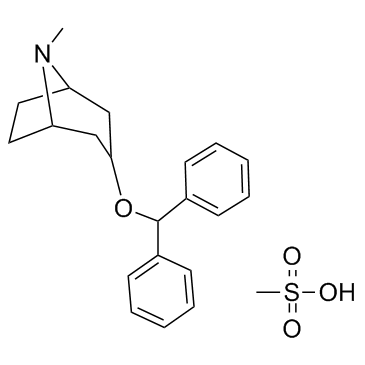Benztropine Mesylate
Modify Date: 2025-08-22 19:12:05

Benztropine Mesylate structure
|
Common Name | Benztropine Mesylate | ||
|---|---|---|---|---|
| CAS Number | 132-17-2 | Molecular Weight | 403.535 | |
| Density | N/A | Boiling Point | 547.8ºC at 760 mmHg | |
| Molecular Formula | C22H29NO4S | Melting Point | 135 °C(lit.) | |
| MSDS | Chinese USA | Flash Point | 285.1ºC | |
| Symbol |

GHS06 |
Signal Word | Danger | |
Use of Benztropine MesylateBenzotropine is a centrally-acting, antimuscarinic agent used as an adjunct in the treatment of Parkinson's disease.Target: mAChRBenzotropine is a centrally-acting, antimuscarinic agent used as an adjunct in the treatment of Parkinson's disease. It may also be used to treat extrapyramidal reactions, such as dystonia and Parkinsonism, caused by antipsychotics. Symptoms of Parkinson's disease and extrapyramidal reactions arise from decreases in dopaminergic activity which creates an imbalance between dopaminergic and cholinergic activity. Anticholinergic therapy is thought to aid in restoring this balance leading to relief of symptoms. In addition to its anticholinergic effects, benztropine also inhibits the reuptake of dopamine at nerve terminals via the dopamine transporter. Benzotropine also produces antagonistic effects at the histamine H1 receptor [1, 2].Benztropine (BZT) and its analogues inhibit dopamine uptake and bind with moderate to high affinity to the dopamine transporter (DAT). BZT analogues also exhibit varied binding affinities for muscarinic M(1) and histamine H(1) receptors. The BZT analogues showed a wide range of histamine H(1) receptor (K(i)=16-37,600 nM) and DAT (K(i)=8.5-6370 nM) binding affinities [3]. |
| Name | benzatropine mesylate |
|---|---|
| Synonym | More Synonyms |
| Description | Benzotropine is a centrally-acting, antimuscarinic agent used as an adjunct in the treatment of Parkinson's disease.Target: mAChRBenzotropine is a centrally-acting, antimuscarinic agent used as an adjunct in the treatment of Parkinson's disease. It may also be used to treat extrapyramidal reactions, such as dystonia and Parkinsonism, caused by antipsychotics. Symptoms of Parkinson's disease and extrapyramidal reactions arise from decreases in dopaminergic activity which creates an imbalance between dopaminergic and cholinergic activity. Anticholinergic therapy is thought to aid in restoring this balance leading to relief of symptoms. In addition to its anticholinergic effects, benztropine also inhibits the reuptake of dopamine at nerve terminals via the dopamine transporter. Benzotropine also produces antagonistic effects at the histamine H1 receptor [1, 2].Benztropine (BZT) and its analogues inhibit dopamine uptake and bind with moderate to high affinity to the dopamine transporter (DAT). BZT analogues also exhibit varied binding affinities for muscarinic M(1) and histamine H(1) receptors. The BZT analogues showed a wide range of histamine H(1) receptor (K(i)=16-37,600 nM) and DAT (K(i)=8.5-6370 nM) binding affinities [3]. |
|---|---|
| Related Catalog | |
| References |
| Boiling Point | 547.8ºC at 760 mmHg |
|---|---|
| Melting Point | 135 °C(lit.) |
| Molecular Formula | C22H29NO4S |
| Molecular Weight | 403.535 |
| Flash Point | 285.1ºC |
| Exact Mass | 403.181732 |
| PSA | 75.22000 |
| LogP | 4.94050 |
| Vapour Pressure | 7.83E-13mmHg at 25°C |
| InChIKey | CPFJLLXFNPCTDW-IIPFOPBBSA-N |
| SMILES | CN1C2CCC1CC(OC(c1ccccc1)c1ccccc1)C2.CS(=O)(=O)O |
| Storage condition | 2-8°C |
CHEMICAL IDENTIFICATION
HEALTH HAZARD DATAACUTE TOXICITY DATA
MUTATION DATA
|
| Symbol |

GHS06 |
|---|---|
| Signal Word | Danger |
| Hazard Statements | H301 + H311 + H331 |
| Precautionary Statements | Missing Phrase - N15.00950417-P261-P280-P302 + P352 + P312-P304 + P340 + P312-P403 + P233 |
| Hazard Codes | T: Toxic; |
| Risk Phrases | R23/24/25 |
| Safety Phrases | S36/37/39-S45 |
| RIDADR | UN 2811 6.1/PG 3 |
| WGK Germany | 3 |
| RTECS | YM3150000 |
| HS Code | 2933990090 |
| HS Code | 2933990090 |
|---|---|
| Summary | 2933990090. heterocyclic compounds with nitrogen hetero-atom(s) only. VAT:17.0%. Tax rebate rate:13.0%. . MFN tariff:6.5%. General tariff:20.0% |
|
A screen of approved drugs and molecular probes identifies therapeutics with anti-Ebola virus activity.
Sci. Transl. Med. 7 , 290ra89, (2015) Currently, no approved therapeutics exist to treat or prevent infections induced by Ebola viruses, and recent events have demonstrated an urgent need for rapid discovery of new treatments. Repurposing... |
| 3a-(Diphenylmethoxy)-1aH,5aH-tropane Methanesulfonate |
| (3-endo)-3-(diphenylmethoxy)-8-methyl-8-azabicyclo[3.2.1]octane methanesulfonate |
| 3-(Benzhydryloxy)-8-methyl-8-azabicyclo[3.2.1]octane methanesulfonate |
| MFCD00074784 |
| Benztropine methanesulfonate |
| Benzotropine Mesylate |
| EINECS 205-048-8 |
| Cobrentin methanesulfonate |
| BENZTROPINE MESYLATE |
| Methansulfonsäure--(3-endo)-3-(diphenylmethoxy)-8-methyl-8-azabicyclo[3.2.1]octan(1:1) |
| 8-Azabicyclo[3.2.1]octane, 3-(diphenylmethoxy)-8-methyl-, (3-endo), methanesulfonate (1:1) |
| Tropine benzohydryl ether methanesulfonate |
| endo-3-(Diphenylmethoxy)-8-methyl-8-azoniabicyclo(3.2.1)octane methanesulphonate |
| (3-endo)-3-(Diphenylmethoxy)-8-methyl-8-azoniabicyclo[3.2.1]octane methanesulfonate |
| Cogentin |
| 8-Azabicyclo[3.2.1]octane (3-(diphenylmethoxy)-8-methyl |

